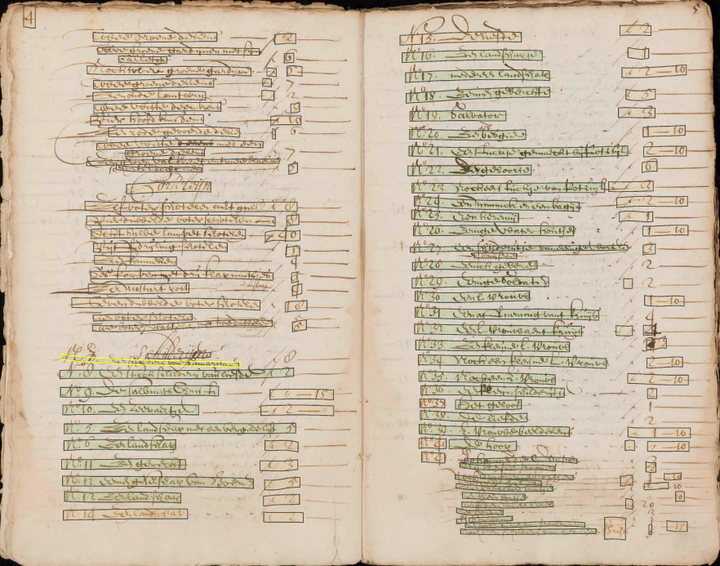 Probate inventory
Probate inventory
For background information and references, see our paper.
The demo shows the intersection of datasets the Golden Agents project is working with, as shown on top of a single archival book (NA 2408) from the Amsterdam City Archives. The demo is built with Mirador version 3 and uses the iiif Presentation API version 3.0. The images that are shown are coming from a static source, but can be served by a iiif-server, serving the image API.
Every Canvas in this manifest shows a scan of a double page spread of this archival book that is dated around 1648 and contains mostly probate or estate inventories taken by a single notary. In these notarial deeds, the contents of a house are described, as part of a legal documentation of someones belongings and therefore possible inheritance. Every notarial deed in this book consists of one or multiple pages and therefore scans. This information is coming from the (1) index on this book that the Amsterdam City Archives provide, in which they already identified the type of deed, its date, the persons that are mentioned, and the respective pages it is listed on. Secondly, separate from this, an (2) HTR-output is provided through the Transkribus tool, that gives the transcription of every text line it has automatically identified.
Finally, on top of this, we have the transcriptions that were once made by economist and art-historian John Michael Montias, who contributed his initial work to the Getty Research Institute in Los Angeles and later continued his work at The Frick Collection in New York. Although sharing the same starting point, the two datasets he left behind at the respective institutes with provenance information on the probate inventories’ owners and their belongings were each expanded, complemented, and corrected separately. Nowadays the data can be found in the (3) Getty Provenance Index and in the (4) Frick Collection’s Montias Database of 17th Century Dutch Art Inventories. We connected the inventory descriptions from these datasets to the index of the Amsterdam City Archive by matching on date and owners. The items identified in these datasets are connected to the HTR-annotations by matching on item transcription. The in the Golden Agents project developed tool Lenticular Lenses was used for this.
Bringing these four datasets together gives a modern day digital humanities art historical scholar the right material to asses the validity of these transcriptions and the claims that were made on top of these descriptions. By directly going back to the archival material, it becomes immediately apparent that only a fraction of these inventories has been transcribed. Not only does this provide the necessary context for the item descriptions, it also highlights differences in spelling and classification, that are the result of changing interpretation strategies of the researchers working with this material.
This demo shows the possibilities and the ease of working with archival material by transparently showing the resources from various content provides on top of each other.
Demo
Annotations to items from the Getty and Frick datasets can be found on pp. 4-8, pp. 20-22, p. 33, pp. 216-217.
N.B.: Using a RC version of Mirador 3. Images served as static (image API level 0). You can try the manifest.json in any viewer that supports annotations and the iiif Presentation API 3.0 (though you might need to fix the relative URIs in the manifest). Not all pages have been transcribed (through HTR), and not all listed record have an equal entry in the datasets of the Getty Provenance Index and the Frick’s Montias Database. The line annotations highlighted in green include items from the Getty/Frick datasets. Matching of the items in the Getty and Frick datasets to a line annotation was done automatically and some links could therefore be missing or are wrongly matched. Due to the high number of annotations per Canvas, navigating the page can be slow.